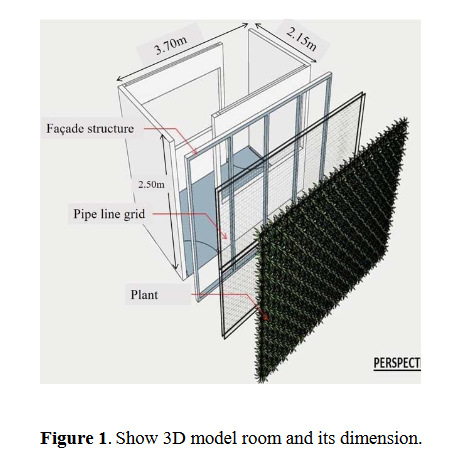PM 2.5 Reduction by Installation of Facade with Broad Leaf and Narrow Leaf Plant
Keywords:
Facade, PM 2.5, Broad leaf plant, Narrow leaf plant, Green facadeAbstract
PM 2.5 has been an important issue for living in a city due to its negative health impact. PM 2.5 reduction by green facade was studied in this experiment. The steel facade with 3.70 x 2.50 m was installed at the front of the model room which located near the 4 lanes road. Broad leaf and narrow leaf plant as Epipremnum aureum and Chlorophytum comosum were attached to the facade for 2 weeks. The inside and outside air quality of the model room as PM 2.5, temperature, relative humidity were hourly observed. The result showed that the installation of a facade or green facade could significantly reduce PM 2.5 and heat through the model room via shading and plant evapotranspiration. Both Epipremnum aureum and Chlorophytum comosum gave better PM 2.5 reduction than
steel facade which corresponding to the leaf area index (LAI) during the experiment.
References
Alexandri, E. , & Jones, P. (2007). Developing a one-dimensional, heat and mass transfer algorithm for describing the effect of green
roofs on the built environment: Comparison with experimental results. Building and Environment, 42, 2835-2849.
Bache, D. H. (1979). Particle transport within plant canopies - I. A framework for analysis. Atmospheric Environment, 13(9), 1257-1262.
Beckett, K. P. , Freer-Smith, P. H. , & Taylor, G.(2000). Particulate pollution capture by urban trees: Effect of species and windspeed. Global
Change Biology, 6, 995-1003.
Chiquet, C., Dover, J. W., & Mitchell, P. (2013). Birds and the urban environment: The value of green walls. Urban Ecosystems, 16, 453-462.
Chow, J. C., Watson, J. G., Mauderly, J. L., Costa, D. L., Wyzga, R. E., Vedal, S., ... Dockery,D. W. (2006). Health effects of fine particulate air pollution: lines that connect. Journal of the Air & Waste Management Association, 56(10), 1368-1380.
Currie, B. A., & Bass, B. (2008). Estimates of air pollution mitigation with green plants and green roofs using the UFORE model. Urban
Ecosystems, 11, 409-422.
Dochinger, L. S. (1980). Interception of airborne particles by tree plantings. Journal of Environmental Quality, 9(2), 265-268.
Dover, J. W. (2015). Green infrastructure:Incorporating plants and enhancing biodiversity in buildings and urban environments. London: Routledge.
Dzierzanowski, K., Popek, R., Gawronska, H., Saebo, A., & Gawronski, S. W. (2011). Deposition of particulate matter of different
size fractions on leaf surfaces and in waxes of urban forest species. International Journal of Phytoremediation, 13, 1037-1046.
Freer-Smith, P. H. , Beckett, K. P. , & Taylor, G. (2005). Deposition velocities to Sorbus aria, Acer campestre, Populus deltoides x
trichocarpa Beaupre, Pinus nigra and x Cupressocyparis leylandii for coarse, fine and ultra-fine particles in the urban environment.
Environmental Pollution, 133(1), 157-167.
Jepson, P. (2016). A rewilding agenda for Europe:Creating a network of experimental reserves. Ecography, 39, 117-124.
Johnston, J., & Newton, J. (2004). Building green: A guide to using plants on roofs, walls and pavements. London: Greater London
Authority.
Kleeman, M. J., Riddle, S. G. , Robert, M. A. ,Jakober, C. A., Fine, P. M., Hays, M. D., ... Hannigan, M. P. (2009). Source apportionment of fine (PM 1.8) and ultrafine (PM0.1) airborne particulate matter during a severe winter pollution episode. Environmental Science and Technology,
(2), 272-279.
Panrare, A., Sohsalam, P. , & Tondee, T. (2015). Constructed wetland for sewage treatment and thermal transfer reduction. Energy Procedia,
, 567-575.
Ram, S. S., Majumder, S., Chaudhuri, P., Chanda, S., Santra, S. C., Maiti, P. K., ... Chakraborty, A. (2012). Plant canopies: Bio-monitor and
trap for re-suspended dust particulates contaminated with heavy metals. Mitigation and Adaptation Strategies for Global Change,
, 499-508.
Seaton, A., Godden, D. , MacNee, W. , & Donaldson, K. (1995). Particulate air pollution and acute health effects. The Lancet, 345,176-178.
Weerakkody, U., Dover, J. W., Mitchell, P., & Reiling, K. (2018). Quantification of the traffic-generated particulate matter capture by
plant species in a living wall and evaluation of the important leaf characteristics. The Science of the Total Environment, 635, 1012-1024.
World Health Organization. (2014). WHO's Ambient Air Pollution database: Data summary of the AAP database. Retrieved
from http: / / www. who. int/ phe/ health_topics/outdoorair/databases/cities/en/













